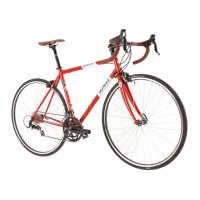41
/
spray
lubricant
Carbon parts cannot be bent, dented
or misshapen after an accident/fall. If
this is the case, it is possible that the
bres have been destroyed or have broken
off, e.g. within the part, which is not visible
from the exterior!
Therefore, it is vital to regularly check car-
bon frames and other carbon components
very carefully, especially after a fall or an ac-
cident.
• Look for splinters, tears, deep scratches,
holes or other changes in the carbon surface.
• Check if the parts have got softer or less
stiff than usual.
• Check if individual layers (paint, nish or
bres) come off.
• Listen for any cracking or other usual
sounds.
If you are not completely certain that your
bicycle is in perfect condition, please allow
a specialist retailer to check the affected car-
bon parts!
Some carbon components require
lower torques than metal parts. Ex-
cessive torques can lead to hidden
damage, which is possibly not visible from the
outside. Frames or components can break
or warp to such an extent that you could fall.
Therefore please always adhere to the in-
structions supplied by the manufacturer or
ask for advice from a specialist. Use a torque
spanner to ensure that you get the required
torque. Carbon parts may not be applied with
grease or oil. Special assembly paste is avail-
able for assembling and safely securing car-
bon components with a low mounting torque.
Never expose carbon parts to high tempera-
tures! Even in the back of cars, the sun‘s rays
can generate such a heat that it can put the
safety of carbon parts at risk.
Do not clamp a carbon frame directly into a
work stand, instead you should secure it by
the seat post. If the seat post is also made of
carbon, use another tube made of metal.
The following components and parts
made of carbon bre should be regu-
larly checked (at least every 100 km)
for irregularities such as cracks, breaks or
changes to the surface, as well as after the bi-
cycle has fallen over or following an accident:
Transition area of the threaded bushing of
the drink holder, slot of the dropouts, bearing
areas in full-suspension frame, suspension
mounting elements on the main frame and
rear suspension, seat clamp, derailleur hang-
er, derailleur clamp area, disc brake mounting
or brake boss, press-t area of the headset as
well as the threads of the bottom bracket cups.
Carbon =
How to use carbon components
If you have a carbon frame or parts,
these should not be applied with
grease or oil. Please use special as-
sembly paste for carbon parts.
Carbon is a material which requires special han-
dling and care during construction, servicing, rid-
ing , transport and storage.
Properties of carbon bre

